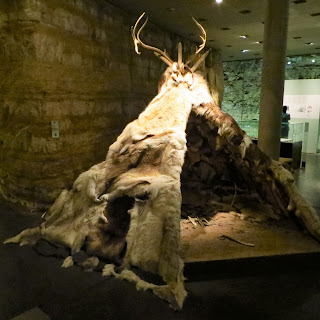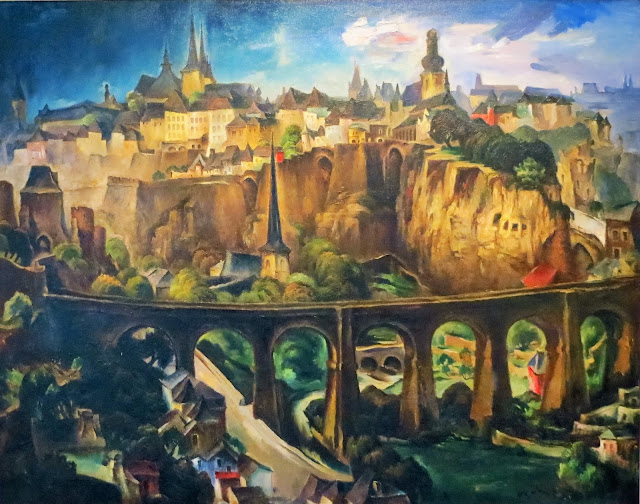For our last day on the Moselle, it formed the border between Germany and Luxembourg. Our first picture looks slightly downstream and across to the Grand Duchy. Looks much the same as the valley we've been in for a week.
From our hotel in Germany the next morning, we got a view of the hill we'd be tackling, starting in the town of Remich, Luxembourg in the bottom right, then angling up the hill on a back road you can just make out passing behind the multicolored hot air balloon.
Alas, we first had to deal with two more broken spokes, discovered when we heard a clicking sound while riding through Remich. Jeff replaced them easily enough, but they were our last spares for the rear wheel. Sure hope we can find a top-notch bike shop that has a spoke-cutting machine, since ours are non-standard due to the small wheels.
Though there is a more gradual way of ascending on a still-challenging 6 or 7% grade, we took a shortcut and walked the bike up a steep street. When we remounted we had done about a fourth of the elevation gain, but the rest was quite manageable using not the lowest but actually the 3rd or 4th-lowest of our 14 speeds. The view from the top was a great reward!
It was a Sunday and Lycra-clad weekend warriors passed us frequently, sometimes singly or in 2s and 3s, sometimes in pelotons of a dozen or more. We told ourselves that it was the luggage we were hauling, not our ages, that made our speed demonstrably more . . . casual.
Luxembourg's "Piste Cyclable" (Bike Route) 7 got us about a fourth of the way to our destination, Luxembourg City. There was supposed to be a PC 11 to connect to, but we never saw a single sign, even though we took some of the roads it was supposed to be using. In the end we took local roads which had no shoulders, but also virtually no traffic. And virtually no flat stretches either. Between the stress of the spokes, the missing bike route signs and the we-wish-they-were-missing hills, it was a challenging 40 km.
The friendliness of the hotel staff and the view from our 6th floor room made up for all that. The Grand Hotel Cravat was where Gen. Omar Bradley had just set up headquarters when the Battle of the Bulge began a few miles from here, and his stay was abruptly shortened. Don't you just hate it when stuff like that happens to you? Our bike had a place of honor a few feet from the General's photo in the lobby when the staff saw that our long tandem was not going to fit in the bike closet that "normal" bikes used. As for the view, that's the Petrusse valley below us just after sunset, with Gelle Fra at eye level with us as she honors Luxembourg's war dead from WW I and WW II.
It was clear from the time we crossed the Moselle that we were in a different country. Although French, German and Luxembourgish are the three official languages of Luxembourg, we found that signs were rarely in more than one language, and that language was French. Ooh, boy, it's been 49 years since Jeff's one year of college French, several more since Louise's study of it in high school, and neither of us has used it since. This could be fun . . . In any event, the main indoor attraction for us in town was the Musee National d'Histoire et d'Art. Their info was in English as well as French and German, and in fact most everyone we met in our touristic endeavors functioned well in all three languages. Whew, dodged that one.
The lower floors of the History and Art Museum are where the history collection was, fantastically framed by the walls of sandstone that were left rough-cut when they dug out the foundation for the museum. A re-creation of a teepee-like dwelling made from furs was a highlight of the prehistory section. Since Luxembourg had several Roman outposts 2,000 years ago, the museum has a terrific collection of Roman antiquities, including a mosaic floor the size of a modern efficiency apartment.
In the art section we captured an image of a painting that captures Luxembourg's architectural and geological charm, perched as it is high above the Alzette and Petrusse Rivers. Like Quebec City, it has an upper town and a lower town -- actually three lower towns separated by short gaps.
Grund is the lower town just below the prominent ridge called Rocher du Bock, or simply "the Bock." That's the view from the top, above, and from below in the photos to the side and below. It's a pretty good chunk of stone.
In the 1700s they really got to work carving defensive tunnels in it, 23 km in all! For a few euros, Jeff poked around for a while. Nowadays there's probably only a little over a km open, but that's still a lot of territory underground. On one side you could see one of Luxembourg's fantastic train viaducts, with skyscrapers of EU agencies in the distance. On the other side you got a gunner's perspective on the lower town of Grund.
The Bock is actually separated from the rest of the upper town by a chasm filled by this impressive bridge, built in 1735. While it's obvious that one can walk across the top and across the center section to get from town to the Bock or vice versa, what the defenders counted on was that attackers wouldn't even imagine that there is a third connection for emergency entrance or exit, a tunnel cut into the limestone deep below the pillars of the bridge. Jeff didn't know about it either until, like Alice in Wonderland, he went spiraling down and down and down, only to walk a mere 50 meters forward and then start spiraling right back up. Well, it was good cross-training to complement the biking, right?
We had come to Luxembourg in part because it had an easy train connection to our next river, the
Meuse. Between us and the Meuse was 200 km of a very dense and very hilly forest known as the Ardennes. Not our kind of biking any more. Belgian trains all take bikes, including tandems, but our first train required the conductor to find a locked passageway where we could bungy it to the wall -- the regular bike area was far too short. For our second train we watched 4 cars of the train come into the station, none marked for bikes. So we got into the fifth car and made do. Luckily it was almost empty. We later found out from the conductor that the sixth/last car had a bike section. No lecture, just an FYI for your next trip, merci beaucoup.
Meuse. Between us and the Meuse was 200 km of a very dense and very hilly forest known as the Ardennes. Not our kind of biking any more. Belgian trains all take bikes, including tandems, but our first train required the conductor to find a locked passageway where we could bungy it to the wall -- the regular bike area was far too short. For our second train we watched 4 cars of the train come into the station, none marked for bikes. So we got into the fifth car and made do. Luckily it was almost empty. We later found out from the conductor that the sixth/last car had a bike section. No lecture, just an FYI for your next trip, merci beaucoup.
We'll pick up our next entry with our trip down River #4, the Meuse.


























No comments:
Post a Comment